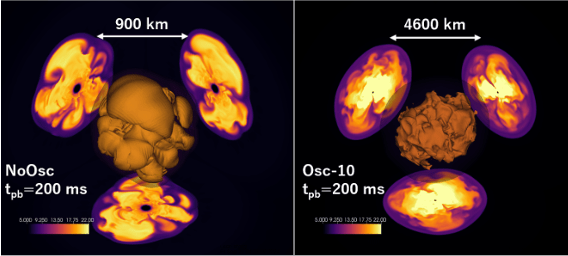Division of Science, NAOJ
3D Core-collapse Supernova Simulations with Neutrino Collective Oscillations

Core-collapse supernovae are an energetic explosion that occurs at the end of the life of massive stars which are more than 10 times heavier than the Sun. Supernovae eject heavy elements created inside the star into interstellar space and drive the chemical evolution of the Universe. Therefore, in order to understand the origin of matter that composes our Universe, it is essential to understand the mechanism of supernova explosions.
It is widely known that elementary particles called neutrinos play an essential role in the mechanism of supernovae. There are three flavors of neutrinos in nature, and they can oscillate as they propagate. This phenomenon is called neutrino oscillations, and Prof. Takaaki Kajita and Prof. Arthur McDonald, who experimentally discovered this phenomenon, were awarded the Nobel Prize in Physics in 2015. Recent theoretical studies have shown that, in extremely dense environments such as the inside of collapsing stars, the so-called collective oscillations are induced by the neutrino self-interaction, which can have a significant impact on the mechanism of supernova explosions. However, because the method to treat collective oscillations from the first principles requires a huge amount of computational resources, three-dimensional supernova simulations that take the collective oscillations into account have not been realized.
The research group including Kanji Mori (JSPS Research Fellow) and Prof. Tomoya Takiwaki at National Astronomical Observatory of Japan adopted a phenomenological method to treat the collective neutrino oscillations to realize three-dimensional simulations that takes them into account. As a result of the simulations, it was revealed that the mean energy of electron antineutrinos that contribute to heating is larger than in conventional supernova models, so that the explosion energy of supernovae is several to ten times larger than conventional predictions. On the other hand, it has been pointed out that conventional multidimensional supernova simulations that do not take neutrino oscillations into account have the problem that the explosion energy is smaller than that of observed supernova events. This research has revealed that neutrino oscillations can solve the problem, which has been a problem in supernova physics for the past decade. In the future, they plan to explore methods to consider neutrino oscillations more accurately, and to perform similar simulations that take into account various progenitor models and stellar rotation, in order to understand the impact of neutrino oscillations on the supernova mechanism.
The results of this study were published from the Publications of the Astronomical Society of Japan. Kanji Mori received the UKAKUREN Young Scientist Award for this research.
https://www.cns.s.u-tokyo.ac.jp/ukakuren/indexnew_e.html
A figure in this paper appeared on the journal cover.
https://academic.oup.com/pasj/issue/77/2
【Publication Information】
Journal: Publications of the Astronomical Society of Japan
Title: “Three-dimensional core-collapse supernova models with phenomenological treatment of neutrino flavor conversions”
Authors: Kanji Mori, Tomoya Takiwaki, Kei Kotake, Shunsaku Horiuchi
URL: https://academic.oup.com/pasj/article-abstract/77/2/L9/8081678

